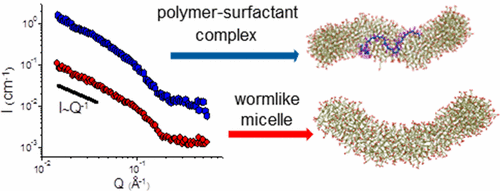当前位置:
X-MOL 学术
›
Macromolecules
›
论文详情
Our official English website, www.x-mol.net, welcomes your
feedback! (Note: you will need to create a separate account there.)
Wormlike Surfactant Micelles with Embedded Polymer Chains
Macromolecules ( IF 5.1 ) Pub Date : 2017-09-05 00:00:00 , DOI: 10.1021/acs.macromol.7b01500 Alexander L. Kwiatkowski 1 , Hari Sharma 2 , Vyacheslav S. Molchanov 1 , Anton S. Orekhov 3 , Alexander L. Vasiliev 3 , Elena E. Dormidontova 2 , Olga E. Philippova 1
Macromolecules ( IF 5.1 ) Pub Date : 2017-09-05 00:00:00 , DOI: 10.1021/acs.macromol.7b01500 Alexander L. Kwiatkowski 1 , Hari Sharma 2 , Vyacheslav S. Molchanov 1 , Anton S. Orekhov 3 , Alexander L. Vasiliev 3 , Elena E. Dormidontova 2 , Olga E. Philippova 1
Affiliation

|
Active use of wormlike micelle (WLM) solutions in a broad range of applications demands control of their viscoelastic properties under different external conditions that can be achieved by using hybrid materials, such as polymer–surfactant complexes. Understanding the properties of such hybrid materials remains a challenge. Using a combination of several experimental techniques with molecular dynamics simulations, we investigate the interaction of poly(4-vinylpyridine) with WLMs of the anionic surfactant potassium oleate. We find that this polymer is solubilized by the micelles at the interface between the tails and headgroups of surfactant, thus screening the hydrophobic polymer backbone from interactions with water while maintaining hydrogen bonding between the pyridine rings and water. By use of SANS with contrast variation, it was shown that the macromolecules associated with the micelles have an expanded coil-like conformation with persistence length 4-fold higher than that of a polymer chain in a good solvent. The rheological behavior of the micellar solutions shows that at low polymer concentrations (regime I) the system maintains high viscoelasticity with the plateau modulus remaining almost unchanged, while the zero-shear viscosity slightly decreases. At higher polymer concentrations (regime II), the viscosity drops by more than 4 orders of magnitude, approaching that of pure solvent. The transition from the I to II regime occurs when the number of added macromolecules is approximately equal to the number of elastically active strands in micellar network. The observed changes are attributed to polymer-induced shortening of WLMs accompanied by loop and branch formation. The saturated polymer–surfactant complex contains about one surfactant per repeat unit of the polymer and represents a best compromise when the WLM retains its general cylindrical geometry (but not the viscoelastic properties) and the polymer maintains an expanded coil-like conformation.
中文翻译:

嵌有聚合物链的蠕虫状表面活性剂胶束
蠕虫状胶束(WLM)解决方案在各种应用中的积极使用要求控制其在不同外部条件下的粘弹性,这可以通过使用杂化材料(例如聚合物-表面活性剂复合物)来实现。理解这种混合材料的特性仍然是一个挑战。使用几种实验技术与分子动力学模拟的组合,我们调查了聚(4-乙烯基吡啶)与阴离子表面活性剂油酸钾的WLM的相互作用。我们发现该聚合物被表面活性剂的尾部和头基之间的界面处的胶束增溶,从而从与水的相互作用中筛选疏水性聚合物主链,同时保持吡啶环与水之间的氢键。通过使用对比度变化的SANS,结果表明,与胶束相关的大分子具有扩展的线圈状构象,其持久长度比在良好溶剂中的聚合物链的持久长度高4倍。胶束溶液的流变行为表明,在低聚合物浓度(方案I)下,系统保持高粘弹性,而平台弹性模量几乎保持不变,而零剪切粘度略有降低。在较高的聚合物浓度下(方案II),粘度下降了4个数量级以上,接近纯溶剂的粘度。当添加的大分子的数量大约等于胶束网络中的弹性活性链的数量时,就会发生从I到II型状态的转变。观察到的变化归因于聚合物引起的WLM缩短,并伴有环和支链的形成。饱和的聚合物-表面活性剂复合物每个聚合物的重复单元包含约一种表面活性剂,当WLM保持其一般的圆柱几何形状(但不具有粘弹性)并且聚合物保持扩展的卷状构象时,这是一种最佳的折衷方案。
更新日期:2017-09-05
中文翻译:

嵌有聚合物链的蠕虫状表面活性剂胶束
蠕虫状胶束(WLM)解决方案在各种应用中的积极使用要求控制其在不同外部条件下的粘弹性,这可以通过使用杂化材料(例如聚合物-表面活性剂复合物)来实现。理解这种混合材料的特性仍然是一个挑战。使用几种实验技术与分子动力学模拟的组合,我们调查了聚(4-乙烯基吡啶)与阴离子表面活性剂油酸钾的WLM的相互作用。我们发现该聚合物被表面活性剂的尾部和头基之间的界面处的胶束增溶,从而从与水的相互作用中筛选疏水性聚合物主链,同时保持吡啶环与水之间的氢键。通过使用对比度变化的SANS,结果表明,与胶束相关的大分子具有扩展的线圈状构象,其持久长度比在良好溶剂中的聚合物链的持久长度高4倍。胶束溶液的流变行为表明,在低聚合物浓度(方案I)下,系统保持高粘弹性,而平台弹性模量几乎保持不变,而零剪切粘度略有降低。在较高的聚合物浓度下(方案II),粘度下降了4个数量级以上,接近纯溶剂的粘度。当添加的大分子的数量大约等于胶束网络中的弹性活性链的数量时,就会发生从I到II型状态的转变。观察到的变化归因于聚合物引起的WLM缩短,并伴有环和支链的形成。饱和的聚合物-表面活性剂复合物每个聚合物的重复单元包含约一种表面活性剂,当WLM保持其一般的圆柱几何形状(但不具有粘弹性)并且聚合物保持扩展的卷状构象时,这是一种最佳的折衷方案。











































 京公网安备 11010802027423号
京公网安备 11010802027423号